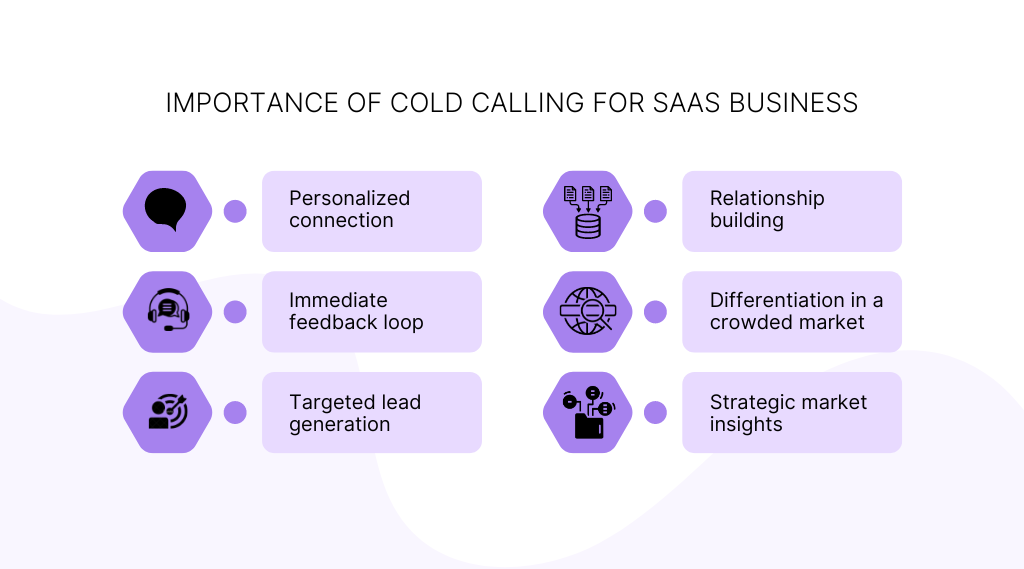Introduction
When executed with precision and finesse, cold calling for saas can be the catalyst that propels your offerings to the forefront of the market.
In this comprehensive guide, we delve into the intricate art of cold calling, unlocking seven game-changing tips tailored to maximize SaaS conversion rates. Embrace these strategies, and let’s pave the way for your SaaS triumphs in 2024 and beyond.
What is Cold Calling?
Before we embark on the journey of mastering cold calling for SaaS conversions in 2024, let’s demystify the essence of cold calling itself.
Cold calling is a proactive outreach strategy where sales professionals initiate contact with potential customers who haven’t expressed prior interest in their product or service.
In the context of SaaS, this means reaching out to businesses or individuals who may not be actively seeking a software solution. The art of cold calling lies in transforming these initial cold contacts into warm leads and eventually loyal customers. It’s about making a connection, showcasing the value of your SaaS offering, and addressing the unique pain points of your target audience.
What is the purpose of cold calling?
Cold calling isn’t merely about reaching out to prospects; it’s a strategic engagement designed to forge meaningful connections and drive conversions. Here are the key purposes that make cold calling an indispensable tool in your SaaS arsenal:
- Initiating relationships
- Showcasing value
- Overcoming objections
- Gathering insights
- Accelerating sales cycle
1. Initiating relationships
Cold calling serves as the initial handshake in the digital realm, allowing you to establish a connection with prospects who might not be actively seeking a SaaS solution. It’s the art of turning a cold lead into a warm prospect.
2. Showcasing value
Beyond a simple introduction, cold calling provides a platform to articulate the unique value proposition of your SaaS offering. It’s an opportunity to highlight features, benefits, and solutions tailored to address the specific needs of your target audience.
3. Overcoming objections
Prospects may have reservations or objections initially. Cold calling allows you to address these concerns in real-time, fostering trust and credibility. It’s a chance to showcase your expertise and alleviate any doubts.
4. Gathering insights
Conversations initiated through cold calling offer invaluable insights into the pain points and preferences of your target market. These insights can be leveraged to refine your SaaS strategy and tailor your offering to better meet customer needs.
5. Accelerating sales cycle
Cold calling expedites the sales process by directly engaging with potential customers. It’s a proactive approach that can shorten the sales cycle, making it a potent tool for achieving quick and effective SaaS conversions.
Importance of cold calling for SaaS business
In SaaS, where competition is tough and user needs keep changing, cold calling is a key part of a successful strategy. It plays a big role in growing your business, keeping it strong, and staying ahead of the market. Here’s why it is important:

- Personalized connection
- Immediate feedback loop
- Targeted lead generation
- Relationship building
- Differentiation in a crowded market
- Strategic market insights
1. Personalized connection
In an era dominated by digital interactions, cold calling adds a human touch to your outreach efforts. It enables your SaaS business to establish a personalized connection with potential customers, fostering a sense of trust and rapport that automated communication often struggles to achieve.
2. Immediate feedback loop
Cold calling provides an immediate feedback loop, allowing your sales team to gauge prospect reactions, address concerns, and adapt their pitch in real-time. This rapid adaptability is invaluable in refining your SaaS offering and tailoring it to the ever-changing needs of your target audience.
3. Targeted lead generation
While inbound marketing strategies generate leads from those actively seeking solutions, cold calling opens the door to a broader audience. It empowers your SaaS business to proactively target and engage with potential customers who might not be aware of their need for your solution, thereby expanding your reach and potential customer base.
4. Relationship building
Beyond immediate conversions, cold calling lays the foundation for long-term relationships. It’s not just about closing a deal; it’s about cultivating a relationship with your customers. These connections can lead to upsells, referrals, and a loyal customer base that becomes an advocate for your SaaS brand.
5. Differentiation in a crowded market
Cold calling provides an opportunity to showcase what sets your SaaS offering apart. You differentiate your brand in a crowded and competitive market by articulating your unique value proposition directly to potential customers.
6. Strategic market insights
Engaging in conversations through cold calling yields valuable insights into market trends, pain points, and emerging needs. These insights are a treasure trove for refining your SaaS strategy, enhancing features, and staying one step ahead of the competition.
What are warm vs cold calls?
In the world of sales, the terms “warm calls” and “cold calls” represent two distinct approaches, each with its own set of strategies and implications. Understanding the difference between these approaches is crucial for orchestrating an effective SaaS cold calling campaign in 2024.
Cold calls
Cold calling involves reaching out to prospects who have had no prior interaction with your SaaS business. These contacts haven’t expressed explicit interest in your offering, making the initial engagement “cold.”
The challenge in cold calling lies in breaking the ice, establishing rapport, and swiftly communicating the value of your SaaS solution. Despite the initial chill, successful cold calls can transform these unfamiliar prospects into warm leads and, eventually, loyal customers.
Warm calls
On the other hand, warm calls involve reaching out to prospects who have shown some level of interest in your SaaS offering. This interest could be manifested through website inquiries, webinar attendance, or engagement with your content.
Warm calls benefit from a foundation of prior interaction, allowing your sales team to build upon existing rapport and tailor their pitch to the prospect’s demonstrated interests. The warmth in these calls stems from the prospect’s pre-existing awareness of your SaaS solution.
What do you do in the first 20 seconds of cold call?
The initial moments of a cold call are akin to the opening act of a captivating performance—they set the tone for the entire interaction. In the fast-paced realm of SaaS cold calling, the first 20 seconds are make-or-break. Here’s a strategic breakdown of what you should aim to accomplish during this critical time frame:
- Introduction with impact
- Establish relevance
- State the value proposition
- Ask a thoughtful question
- Demonstrate confidence
1. Introduction with impact
Open with an impactful introduction that immediately communicates who you are and the purpose of your call. Your introduction should be confident, clear, and tailored to resonate with the prospect. Avoid generic statements; instead, craft an opening that piques curiosity and prompts engagement.
2. Establish relevance
Within the first few seconds, establish why your call is relevant to the prospect. Reference a pain point, industry trend, or challenge that directly aligns with the value proposition of your SaaS offering. This demonstrates that you’ve done your homework and adds a layer of personalization to the conversation.
3. State the value proposition
Quickly transition to the core value proposition of your SaaS solution. Concisely communicate the benefits and outcomes that the prospect stands to gain by engaging with your offering. Focus on addressing their specific needs and challenges, emphasizing how your solution provides a tailored and effective resolution.
4. Ask a thoughtful question
Involve the prospect early on by posing a thoughtful and open-ended question. This encourages engagement and sets the stage for a more interactive conversation. Ensure that the question is relevant to their pain points and prompts them to share insights about their current situation.
5. Demonstrate confidence
Infuse confidence into your tone and demeanor. Confidence is contagious and instills trust in the prospect. Maintain a steady pace, articulate your words clearly, and exude assurance in the value your SaaS solution brings to the table.
7 Cold calling tips for SaaS conversion
Mastering the art of cold calling is a potent catalyst for driving SaaS conversions in the competitive landscape of 2024. Elevate your cold calling game with these seven strategic tips, meticulously designed to maximize your impact and resonate with potential customers:
- Research your prospects thoroughly
- Craft a compelling script
- Utilize multi-channel touchpoints
- Focus on active listening
- Highlight specific benefits and outcomes
- Overcome objections with confidence
- Establish a clear call-to-action
1. Research your prospects thoroughly
Before you pick up the phone, invest time in comprehensive research about your prospects. Understand their industry, pain points, and current challenges. Tailor your cold call to reflect this knowledge, demonstrating a genuine interest in their specific needs. This personalized approach paves the way for a more meaningful conversation.
2. Craft a compelling script
While spontaneity is valuable, having a well-crafted script ensures that your key messages are clear and impactful. Your script should be a guide, not a rigid set of lines. Incorporate the prospect’s name, industry insights, and pain points into your script, allowing for flexibility while maintaining a structured and persuasive narrative.
3. Utilize multi-channel touchpoints
Cold calling shouldn’t exist in isolation. Integrate it with other communication channels like email, social media, and targeted content. A multi-channel approach enhances brand visibility and primes prospects for your cold call, increasing the chances of recognition and receptiveness.
4. Focus on active listening
A successful cold call is a dialogue, not a monologue. Practice active listening to understand the prospect’s needs, concerns, and objectives. Ask probing questions and adapt your responses based on their cues. This not only builds rapport but also allows you to tailor your pitch more effectively.
5. Highlight specific benefits and outcomes
Move beyond generic feature discussions. Clearly articulate the specific benefits and outcomes your SaaS solution brings to the prospect. How will it address their pain points? What tangible results can they expect? Illustrate the value in a way that resonates with their unique challenges.
6. Overcome objections with confidence
Anticipate common objections and equip yourself with confident and well-thought-out responses. Whether it’s addressing budget concerns, competing solutions, or perceived risks, a proactive approach to objections showcases your expertise and instills confidence in the prospect.
7. Establish a clear call-to-action
Conclude your cold call with a clear and compelling call-to-action. Whether it’s scheduling a demo, sending additional resources, or arranging a follow-up call, guide the prospect toward the next step in the conversion journey. A well-defined call-to-action ensures that the momentum generated during the call is translated into actionable steps.
Conclusion
In the dynamic realm of SaaS conversions, cold calling remains a formidable weapon in your arsenal when wielded with precision and empathy in your outbound marketing strategy.
By embracing the 3 C’s—Clarity, Confidence, and Customization—infusing positivity into your interactions, and steering clear of common pitfalls, you’re poised to navigate the evolving landscape of cold calling with finesse.
SaaS conversions aren’t just about closing deals; they’re about building lasting relationships that extend beyond the initial call.
As you embark on your cold calling journey, let the strategies outlined here serve as your compass, guiding you toward a future where each call is a step closer to SaaS triumph.
Remember, successful cold calling is not just about making calls—it’s about orchestrating conversations that resonate, educate, and ultimately convert. Whether you’re a seasoned professional or just stepping into the realm of SaaS, let these strategies be your guide to elevating your cold calling game in 2024 and beyond. Stay agile, stay informed, and above all, stay committed to delivering unparalleled value to your prospects.
Dial our experts and watch as your SaaS brand emerges as a leader in the competitive landscape.
FAQs
1. How long should a cold call last?
– The optimal duration of a cold call depends on various factors, including the complexity of your SaaS offering and the receptiveness of the prospect. As a general guideline, aim for a concise and focused conversation lasting around 5 to 10 minutes. This time frame allows you to deliver a compelling pitch, address initial questions, and gauge the prospect’s interest without overstaying your welcome.
2. What is the hardest part of cold calling?
– The hardest part of cold calling often lies in overcoming initial resistance and objections. Prospects may be skeptical or busy, and navigating these challenges requires a combination of confidence, adaptability, and strategic objection-handling skills. Building rapport and establishing the relevance of your SaaS solution within the first few seconds can be particularly challenging but is crucial for success.
3. Is it better to cold call or text?
– The choice between cold calling and texting depends on your target audience, industry norms, and the nature of your SaaS offering. Cold calling allows for a more personal and interactive connection, while texting can be efficient for brief communications. Ideally, a multi-channel approach that integrates both methods can maximize your reach and engagement with prospects.
4. How many calls should a cold caller make a day?
– The number of calls a cold caller should make per day varies based on factors such as industry, target audience, and the complexity of the SaaS solution. A commonly suggested range is between 50 to 100 calls per day. However, the emphasis should be on quality over quantity—ensuring that each call is well-researched, personalized, and focused on delivering value.
5. Does cold calling work in saas?
– Yes, cold calling can be highly effective in the SaaS industry when executed strategically. It allows for direct engagement with potential customers, providing an opportunity to communicate the unique value proposition of your SaaS offering. When combined with personalized approaches, active listening, and adaptability, cold calling can play a pivotal role in driving SaaS conversions and building lasting customer relationships.



